#Nisga’a Nation
Text
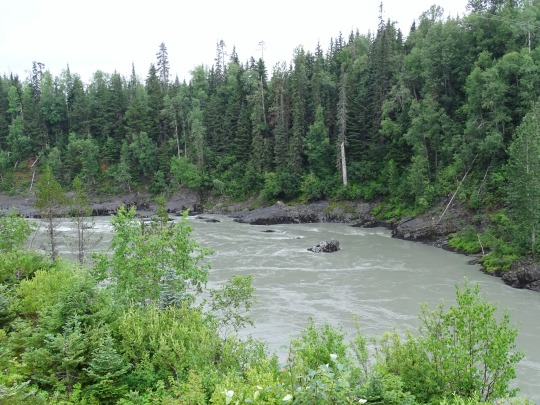
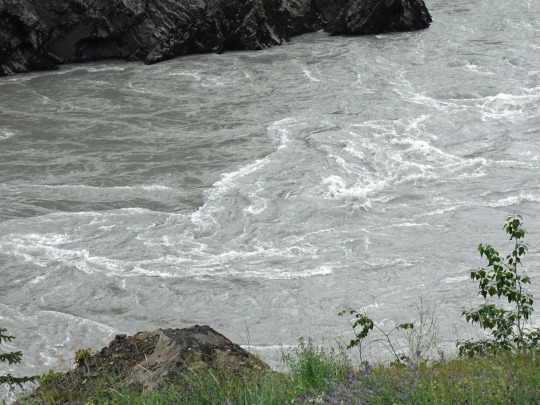


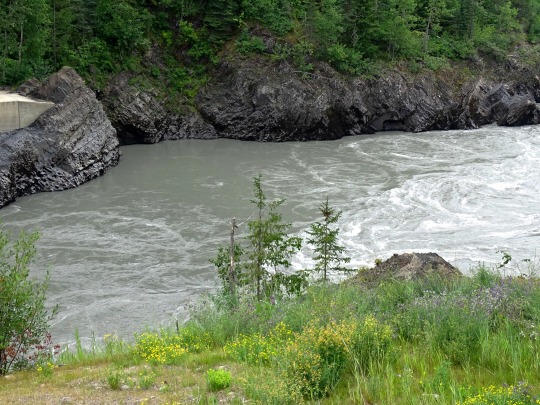





Nass River, BC (No. 1)
The Nass River is a river in northern British Columbia, Canada. It flows 380 km (240 mi) from the Coast Mountains southwest to Nass Bay, a sidewater of Portland Inlet, which connects to the North Pacific Ocean via the Dixon Entrance. Nass Bay joins Portland Inlet just south of Observatory Inlet.
The English name "Nass" is derived from the Tlingit name Naas which means "intestines" or "guts" in reference to the river's large food capacity in its fish (Naish & Story 1963; Leer, Hitch, & Ritter 2001). Can also be a Tlingit word for "food depot". Former spellings are Naas and Nasse. The Nisga'a name for the river is K'alii Aksim Lisims "Lisims (river name) Valley". The Gitxsan name is Git-Txaemsim meaning People of Txeemsim (Raven or Trickster); Xsitxemsem in the dialect of the Gitanyow). Lisims means "murky" in Nisga'a, referring to the river's silt-laden flow.
Source: Wikipedia
#Nass River#Nass Camp#Nass River Bridge#Alfalfa#travel#original photography#vacation#tourist attraction#landmark#landscape#BC#wildflower#Nisga’a Nation#flora#nature#countryside#woods#forest#summer 2023#British Columbia#Canada#engineering
15 notes
·
View notes
Text
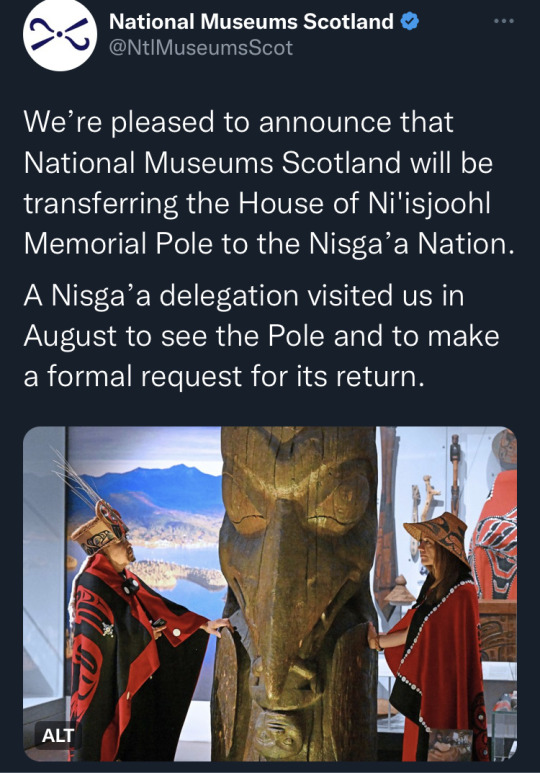
Scotland stole a memorial pole from the Nisga’a Nation - but it’s now being returned which is good. Hopefully the first of many stolen things.
4K notes
·
View notes
Text

Memorial Pole To Be Returned To The Nisga’a Nation After 93 years.
The pole "was acquired in 1929 by Canadian curator and ethnographer, Marius Barbeau, on behalf of the Royal Museum of Scotland, which later became the National Museum of Scotland (NMS), and went on display the following year.
"However, NMS said that while the museum acted in good faith in its acquisition of the pole, it now understands that the individual(s) who 'sold' it to Mr Barbeau did so without the cultural, spiritual, or political authority to do so on behalf of the Nisga’a Nation."
"Carved from red cedar in the 1860s, the pole [37 feet] includes family crests and animal and human figures. It commemorates the Nisga’a warrior Ts’aawit and stood outside his relatives’ home for 70 years before being removed while villagers were away for the annual hunting season."
"The museum agreed last year to return the pole, which has been on display since 1930."
[Source 1] [Source 2] [Source 3]
19 notes
·
View notes
Text
The towering, hand-carved totem pole is being rematriated, not repatriated, and after being put into a sleeping state on Monday
“It was a wonderful occasion,” said the National Museum of Scotland curator, John Giblin, after witnessing the spiritual ceremony to begin the pole’s complicated 4,200-mile journey.
The museum and the Nisga’a delegates are calling it a rematriation, a challenge to the patriarchy and a word that makes sense given that the Nisga’a are a matrilineal society, said Parent, whose Nisga’a name is Noxs Ts’aawit (Mother of the raven warrior chief).
The ease with which the return has taken place is down to a National Museums Scotland policy change on the return of disputed objects, which was decided in 2021 and makes the museum more open to requests.
It has led to what is the first totem pole return by any UK museum.
Giblin would not be drawn on whether other institutions should follow suit.
But he believes the right thing has been done, albeit leaving a sizeable gap in Edinburgh.
“I would personally love there to be a new pole, carved by the Nisga’a nation, in the gallery,” he said.
“We have had conversations with them. If we did do that it wouldn’t be a replica … it would be a pole designed collaboratively that would tell the story of the relationship between the Nisga’a nation and Scotland – both its history and our aspirations for the future.”
2 notes
·
View notes
Text
Hey travellers and (so-called) Western Canada residents of tumblr!
I’m planning a road trip with a bunch of friends throughout BC, Canada and into the NWT and Yukon…I want to be able to tell spooky stories at campfires about local legends and haunts, but LITERALLY all anyone talks about is how haunted Vancouver and Victoria are, as if that’s some kind of secret. Some places I’m totally stumped on are:
Prince George, BC (note: I do already know a fair amount about the highway of tears)
Fort St. John, BC
Dawson Creek, BC
Muncho Lake, BC
Fort Liard, NWT
Watson Lake, YK
Carcross (note: I know about the hotel and hope they’re open again when we go!), YK
Kluane National Park Reserve, YK
Atlin, BC
Anywhere along the Stewart-Cassiar Highway
The Hazeltons
Nisga’a Territory
I’d super appreciate any stories you’ve got to tell! Share your spookies!
#scary stories#haunted bc#British Columbia#northern bc#strange encounters#share stories#travel#travel stories#western Canada#Northwest Territories#Yukon territory#northern Canada#haunted Canada#ghost stories#ghostly encounters
4 notes
·
View notes
Link
[ad_1] A homecoming celebration for a memorial totem pole after an absence of almost 100 years will resonate far beyond the tiny Indigenous village in northwest British Columbia where it is being returned Friday. The House of Ni’isjoohl memorial totem, on display in the National Museum of Scotland in Edinburgh since 1930, returns amid a reckoning for some cultural institutions about colonial legacies. But Indigenous, political, cultural and institutional leaders say the meaning of the totem's journey to its ancestral Nisga'a Nation village home in the remote Nass Valley transcends the return of stolen artwork — it is an act of reconciliation that can open other doors. John Giblin, keeper of global arts, cultures and design at the National Museum of Scotland, said in an interview from Hamburg, Germany, that the Edinburgh institution is committed to "engaging with the colonial history and the colonial legacies of our collections and our practices." Public support in Scotland for the pole's return to the Nass Valley was positive, said Giblin, adding the experience has developed into a fuller relationship between the Nisga'a and the museum and future collaborations are now being considered. Hundreds of people are expected to attend the ceremony welcoming the 11-metre pole back to the Nass Valley, about 1,400 kilometres northwest of Vancouver, after a journey that included a flight aboard a Canadian Armed Forces aircraft. The timing also carries significance. It arrives one day before Canada's National Day for Truth and Reconciliation, held to honour survivors of residential schools and Indigenous children who did not come home. "Museums need to understand this as something that is not about loss or it does not have to be about loss," Giblin said of the pole's return. "If done well and if done in collaboration with communities, it can be about generating new understanding, new relationships." Giblin, who was in Hamburg for a meeting of the European Ethnography Museum directors' group, said he provided members with an update about the return of the Nisga'a totem. Giblin's attitude contrasts with a mindset that once prevailed among some in the global museum community, that "universal museums" held artifacts in multicultural collections for the betterment of humanity as a whole. In a 2002 document called the "Declaration on the Importance and Value of Universal Museums," some of the world's most renowned museums and galleries said that museums "provide a valid and valuable context for objects that were long ago displaced from their original source." It pushed back against calls for repatriation by saying that "museums serve not just the citizens of one nation but the people of every nation." "To narrow the focus of museums whose collections are diverse and multi-faceted would therefore be a disservice to all visitors," it said. The declaration's 18 signatories included the Louvre in Paris, New York's Metropolitan Museum of Art, and the Prado Museum in Madrid. But museums globally are increasingly facing pressure to return items to their rightful owners. The Museum of Fine Arts in Boston, which also signed the 2002 declaration, is now among those looking to return artworks. It has placed a plaque on a display of rare West African works of art, including bronze helmets and swords, saying it was aware the objects were looted by British troops in 1897. New York City passed a law in August 2022 requiring museums to acknowledge works of art as stolen from Jews by the Nazis. The reputation of museums as places of safekeeping has also been eroded. Last month, the director of the British Museum announced his resignation after investigations revealed the theft or disappearance of hundreds of items. Hartwig Fischer apologized for failing to take seriously enough a warning from an art historian that artifacts from its collection were being sold on eBay. "Museums as an idea where they centrally locate objects from around the world for people to view and learn about is in one way a great learning project, but in another way it also represents many of the challenges we see with the experience of colonization and the negative impacts it had on peoples' cultures," said Prof. Geoffrey Bird, of the school of communication and culture at Victoria's Royal Roads University. The return of the memorial totem helps the Nisga'a re-establish their link with their past after the residential school experience where Canadian governments and the church sought to remove people's Indigenous identity, he said. The totem's return provides the opportunity to take reconciliation to a higher level beyond repatriating a work of art, that could lead to improvements in education, infrastructure and technology, said Bird. "I also think it is a gateway to opening the doors to addressing all these other needs in the community," he said. "It's an important step toward generating awareness. These kinds of efforts have spinoff benefits." The Nisga'a Nation and National Museums Scotland are calling the return of the pole a "rematriation," reflecting the matrilineal nature of Nisga'a society. The red cedar pole was taken without the nation's consent in 1929 by an ethnographer researching Nisga'a village life, who then sold it to the Scottish museum. A Nisga'a delegation travelled to Scotland to ask for its return in August 2022, and the museum's board of trustees approved the plan. Amy Parent, a member of the nation and Canada Research Chair in Indigenous education and governance said last month that a previous request for the pole's return two decades ago had been rebuffed on the grounds that the pole was too old to move. Nisga'a Nation President Eva Clayton said the return of the memorial pole helps set the tone for reconciliation efforts by other Indigenous nations. The Nisga'a have a history of leadership, being the first Indigenous nation to sign a modern-day treaty in B.C. in the late 1990s, and ongoing efforts to pursue reconciliation, she said. "It is through the combination of traditional knowledge and western education that has led our nation yet again to the forefront," said Clayton. "This is where we sit as a nation, watching all other nations, whether it be European, North American debating the costs of historical wrongs." The return of the memorial totem could act as a catalyst that will spread worldwide as more countries, governments and institutions face requests by Indigenous people to have their artifacts returned, said Murray Rankin, B.C.'s Indigenous relations and reconciliation minister. "What more poignant example of that than to have after almost 100 years in the Scottish museum, the national museum, such a critically important piece of Nisga'a history returned to the Nisga'a," he said. "To me, it's a wonderful example of the kind of changes that are afoot, long overdue changes in the direction of reconciliation." — With files from The Associated Press This report by The Canadian Press was first published Sept. 28, 2023. [ad_2]
0 notes
Text
The Disappearance Of Michelle Gurney
The Disappearance of Michelle Gurney
Michelle was last seen on December 11, 1998.
#missing #unsolved #coldcase #unforgotten #sharethispost #truecrime
Michelle GurneyCase reference: 2014004103Missing since: December 11, 1998Year of Birth: 1969Age at Disappearance: 29 yearsGender: FemaleEthnicity: IndigenousEye Color: BrownHair: Black, LongHeight: 162 cm / 5 ft 4 inWeight: 45 kg / 100 lbsPhysical Build: MediumComplexion: Dark
Details About Michelle’s Case: Michelle was a member of the Nisga’a First Nation. She was 29 years old when she…

View On WordPress
0 notes
Text
Scottish Museum Will Return Totem Pole to Nisga’a Nation in Canada
The 36-foot tall memorial pole has spent almost a century in a Scottish museum. Now it will be returned to the Nisga’a Nation in Canada.
source https://www.nytimes.com/2023/08/29/world/europe/totem-pole-nisga-a-nation-scotland.html
View On WordPress
0 notes
Text

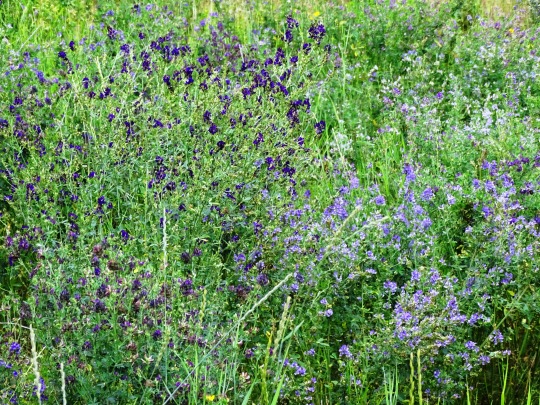
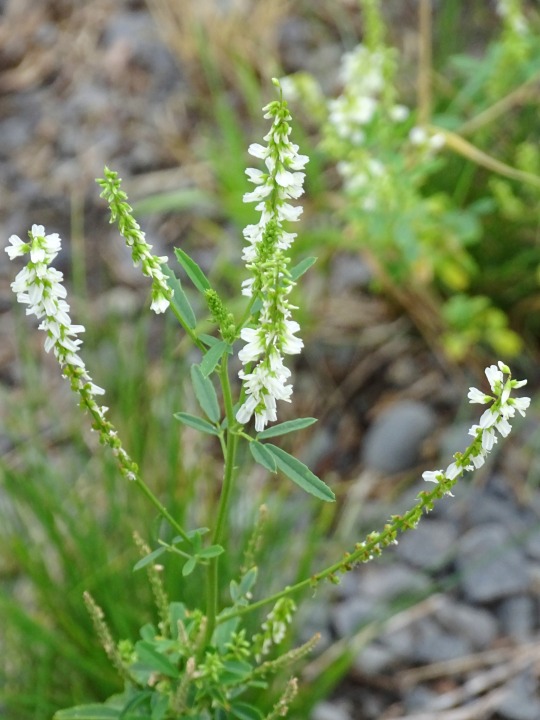








Nass River, BC (No. 2)
The last 40 km (25 mi) of the river are navigable. The river is a commercially valuable salmon fishery. The basin of the Nass is the location of the first modern-day treaty settlement in British Columbia, between the government of that province and the Nisga'a Nation. The name Nisga'a is a reduced form of [naːsqaʔ], which is a loan from Tongass Tlingit, where it means "people of the Nass River".
On the term:
Archdeacon W. H. Collison, an authority on this subject, and who has resided at Kincolith, Nass bay, since 1883, states as follows: - "The term Nass is from the Tlingit tongue, and when, as was probable, the Tlingits from Tongass, at the entrance to Observatory inlet, met Captain Vancouver they gave him their name for the river, i.e., Nass, which means literally "the stomach," from the fact that their food supplies of salmon, oolachan.. a noted fishery."
Nass River Bridge carries Highway 37 over the river
About 220 years ago, as recorded by the oral history of the Nisga'a people, the Nass River was dammed by a 22.5 km (14.0 mi) long lava flow which came from the Tseax Cone and destroyed the Nisga'a villages and caused the death of at least 2000 Nisga'a people by volcanic gas and poisonous smoke. The volcano has been active on at least two occasions (220 and 650 years ago) in the last millennium. Because of our knowledge of this previous disaster, modern monitoring techniques should include studies of the gases emitted by the volcanoes and the institution of a warning system to alert people living down slope from the volcanoes.
Source: Wikipedia
#Nass River#Nass Camp#Alfalfa#travel#original photography#vacation#tourist attraction#landmark#landscape#BC#wildflower#Nisga’a Nation#flora#nature#countryside#woods#forest#summer 2023#British Columbia#Canada#Conyza canadensis#Melilotus albus
2 notes
·
View notes
Text
Antonio Velardo shares: Totem Pole Taken 94 Years Ago Begins 4,000-Mile Journey Home by Emma Bubola
By Emma Bubola
The 36-foot tall memorial pole has spent almost a century in a Scottish museum. Now it will be returned to the Nisga’a Nation in Canada.
Published: August 29, 2023 at 01:18PM
from NYT World https://ift.tt/fdDA2jb
via IFTTT

View On WordPress
0 notes
Text
Tourmaline Throwing Natural Gas Weight to Advance Ksi Lisims LNG Project on Canada’s West Coast
Canada’s largest natural gas producer Tourmaline Oil Corp. has agreed to join Rockies LNG Partners, a group of explorers working to advance a 1.6 Bcf/d export project on the west coast of British Columbia (BC).
The Ksi Lisims floating liquefied natural gas facility as proposed would be sited in the territory of the Nisga’a Nation near Prince Rupert, about 900 miles north of Vancouver.
Last year…

View On WordPress
0 notes
Text
It has been six years since the last new gold mine – Brucejack – went into production in B.C., and as many as three could be pouring the first gold next year: Premier, Blackwater and Cariboo Gold.
Now, as many as three could be pouring the first gold next year: Premier, Blackwater and Cariboo Gold the Premier and Cariboo Gold mines are brownfield projects with historical mining, and the new Artemis Gold Blackwater project south of Prince George is a large greenfield project that will generate a significant number of jobs and economic activity in an area hard hit by a sawmill and pulp mill closures.
Combined, the three new mines represent an initial capital investment of $1.5 billion over the next couple of years and hundreds of new jobs.
The first of the three new gold mines to go into production will be the Premier underground gold mine near Stewart Resources is aiming to pour its first gold by the first quarter of 2024 capital cost of the project is $300 million, and much of the new works are already built or nearing completion.
The mine is located within the Nisga’a treaty lands agreement with the Nisga’a and provides the First Nation with cash payments, training, employment and business opportunities Streaming is helping to finance the mine with a US$110 million gold and silver streaming agreement.
The Premier gold mine has been mined since the early 1900s, most recently as an open-pit operation until the late 1990s, so a lot of the infrastructure needed to operate a mine is in place.
“We have a lot of strategic infrastructure advantages that a greenfield site doesn’t have,” said Ascot CEO Derek White why we’re able to go much quicker benefiting from all the historical infrastructure.”
Ascot has designed a hub-and-spoke approach, with one central mill near the historical Premier mine site, and four distinct deposits, all to be mined underground furthest deposit is 44 kilometres away by road.
Since a lot of the infrastructure is already in place, most of the capital investment has been in refurbishing the mill and a tailings pond and water treatment system.
“In 2023, the big things for us are putting in a new state-of-the-art water treatment plant,” White said expects the mine to produce 150,000 ounces a year, with average grades of 7.5 grams of gold per tonne put that in context, Blackwater’s average annual production would be just under 400,000 ounces per year with gold grades of 0.75 grams per tonne.
“These are high-grade underground deposits,” White said small volume, high-grade will be ramping up to about 200 workers this summer. Once in operation, the mine will employ 230 to 250 miners some of the miners may live in camp at the site, and others may end up living in Stewart, B.C., White said.
With an initial capital cost of $645 million – and up to $1.4 billion total over a 22-year mine life – Artemis Gold’s Blackwater open-pit gold mine south of Vanderhoof will be the largest new mine built in the region in more than a decade, is largely locally owned, with 41 percent of the owners being board members or management, including Vancouver developer Ryan Beedie, who is a director and major shareholder.
“We live here,” said Artemis Gold CEO Steven Dean is our home and our decisions are made here in Vancouver, and not in Toronto or some other head office outside of the province or even outside of the country.”
The Blackwater project was green-lit just last month with the issuance of a Mines Act permit work construction has already started.
“We’re already well into construction,” Dean said Blackwater project will create 500 jobs during an 18-month construction period, with production expected later in the second half of 2024 will employ 300 miners in the first phase of operation and up to 450 in later phase expansions project will expand in phases, with the expansions focused on processing, starting at six million tonnes annually in Phase 1, 12 million tonnes in Phase 2 and 20 million tonnes in Phase 3.
The mine will be in a region that has been hard hit in recent years by a sawmill and pulp mill closures, so it will provide a welcome injection of jobs and tax revenue.
“British Columbians will benefit from hundreds of new jobs of this new mine, with both its construction and multiple decades of operation,” said Josie Osborne, minister of energy, mines and low carbon innovation.
“We’re hoping to be able to support employment and re-employment of some of those people in the forestry sector, maybe with a little bit of retraining into our sector,” Dean said. “Whether it be operators, truck drivers, maintenance people in the mill, there are some common skills between the two industries.”
Wheaton Precious Metals is staking the project with a US$141 million streaming agreement think it’s a robust asset that has some potential upside even beyond what they’ve identified so far,” Wheaton CEO Randy Smallwood said looks like a really good asset that will deliver a lot of gold and silver to us. It’s a strong team that’s had great success building other operations and other mines around the world.”
An economic impact study by KPMG estimates the mine will contribute $13 billion to the B.C. economy over its 22-year life, including $2.3 billion in provincial revenue.
The Blackwater will have a lean carbon emissions profile processing plant that will be fully electric, and therefore zero emission and the company has an agreement with Caterpillar in which the mine’s haul trucks can switch to fully electric in 2029.
“We have an agreement whereby we will be one of the first to receive these pieces of equipment,” Dean said Development has plans to bring the historic gold mining region of Barkerville back to life company had planned to have a new mine in operation last year, but it has been delayed, and the company is now aiming to pour its first gold in 2024.
The project has a total capital cost of close to $600 million – $137 million for the first phase and $451 million for a feasibility study that estimates the mine will produce an average of 163,695 ounces of gold a year over 12 years, with gold grades of 3.72 to 4.43 grams per tonne.
“This feasibility study demonstrates that the Cariboo Gold project will be a large-scale, long-life and profitable gold mine,” said Osisko Development CEO Sean Roosen will also produce significant quantities of gold in its initial years at a capital cost below $140 million.”
0 notes
Text
Scottish museum returning stolen totem pole after visit from Nisga'a Nation
Scottish museum returning stolen totem pole after visit from Nisga’a Nation
The National Museum of Scotland says it will return a memorial totem pole taken nearly a century ago from the Nisga’a Nation in British Columbia.
The museum says its board of trustees approved the First Nation’s request to transfer the pole to its home in northwest B.C.
A delegation of Nisga’a leaders travelled to Edinburgh last August to request the transfer of the 11-metre pole back to their…
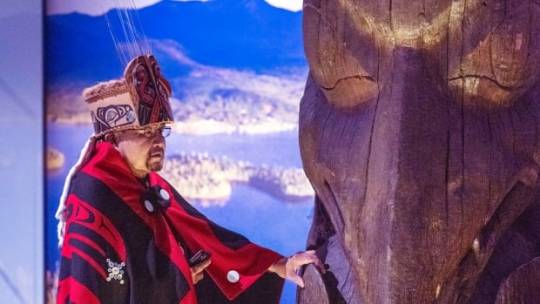
View On WordPress
0 notes
Text
Travel to Scotland | A First Nation wants to recover a totem stolen in 1929
Travel to Scotland | A First Nation wants to recover a totem stolen in 1929
(Vancouver) Delegates from the Nisga’a First Nation will travel to Scotland next week to discuss the possibility of recovering a totem pole said to have been stolen from them nearly a century ago.
Seven members of this British Columbia community, including Chief Earl Stephens, are due to meet curators and politicians at the National Museum of Scotland on Monday.
“This is the first time in living…

View On WordPress
0 notes
Text
Nisga’a of the Nass
Original Post Date July 30, 2021
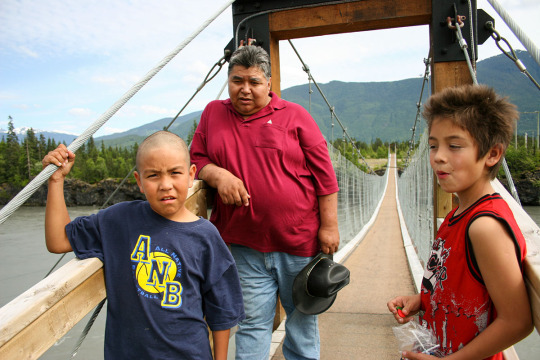
In 2006 I lived in northern Kitimat, BC. My dog, Murphy and I drove up to explore the unique lava beds in the raw wilderness of Nisga’a territory roughly an hour north of Terrace, BC. To First Nations people, the park is known as Anhluut’ukwsim Laxmihl Angwinga’asanskwhl Nisga’a. The park is also known as Nisga’a Memorial Lava Bed Park.
It’s hard to imagine it happening, but around the year 1750 – decades before Europeans came sailing up this way – a volcano erupted here spewing lava and killing over 2,000 Nisga’a people, destroying everything in its path and sparking devastating forest fires.

Murphy explores the lava beds at Nisga’a Memorial Lava Bed Provincial Park
The vast lava beds remain today as a memorial to the lives lost. Nisga’a Memorial Lava Bed Park is a popular destination with a 16-site campground and a Visitors Centre displaying Nisga’a artifacts throughout July and August. There are guided tours of the lava beds, sport fishing, backcountry excursions, local accommodations, and majestic pts’aan (totem poles).

Daman Beatty and his little dog Murphy set off from Kitimat, BC in an old Mazda MX3 Precidia to visit the Nisga’a Memorial Lava Bed Park (July 2006)
It is the first park in BC jointly managed between BC Parks and the Nisga’a Tribal Council. It boasts waterfalls, pools, cinder cones, tree moulds, lava tubes, spatter cones, a lava-dammed lake, caves and other features created by lava flows.
BC Parks’ website says this park offers “a chance to explore many unique and interesting features of a volcanic landscape and to learn about the culture and legends of the Nisga’a people.” This was so very true for us that day after we picked up Kenny Robinson, a Nisga’a man hitchhiking home from Terrace.

The guide, Kenny Robinson
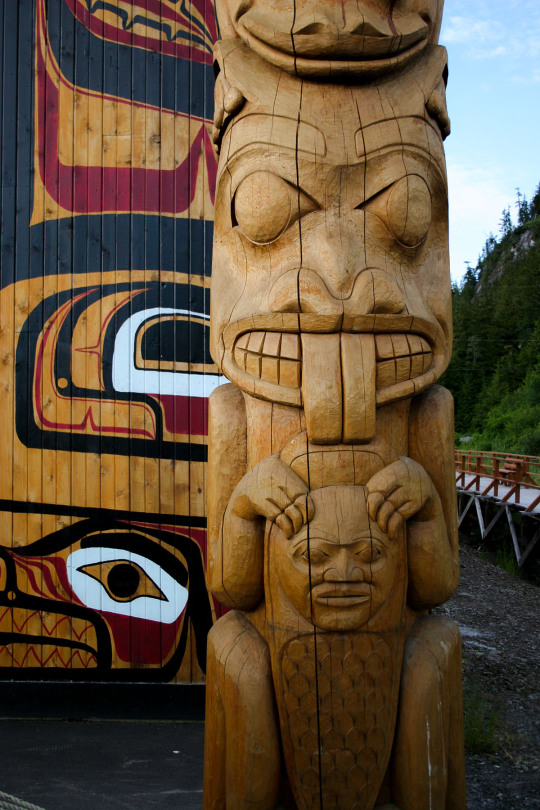
Totem pole and long house in n the village of Gingolx, British Columbia
In exchange for a ride, he offered a guided tour of the lava beds and some Nisga’a villages along the way, including the home of a 400-foot suspension bridge: Gitwinksihlkw (Place of the Lizards) where according to oral tradition, large lizards lived there before the eruption.

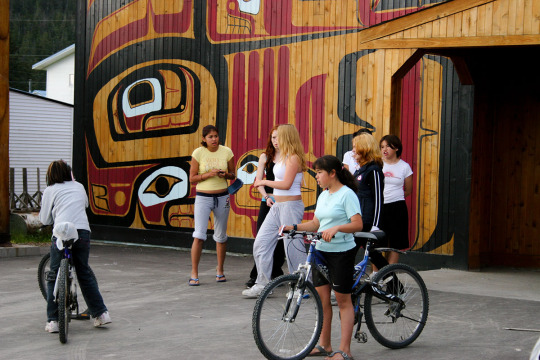
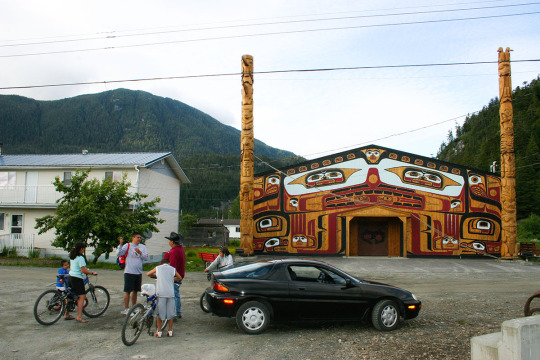
I also received a warm welcome in the breathtaking village of Gingolx with spectacular views of the ocean and soaring eagles. The locals invited me into their long house to draw door prizes for a gathering and showed me how to prepare smoked salmon.
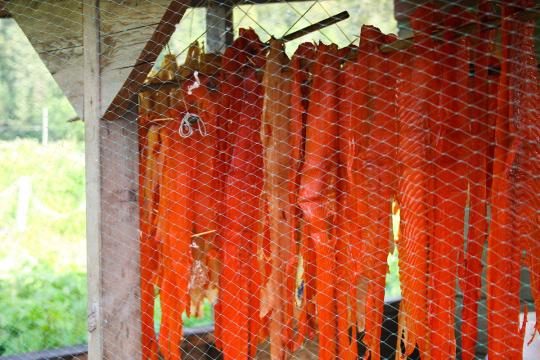
Smoked salmon hanging in a Nisga’a village of Gingolx, British Columbia
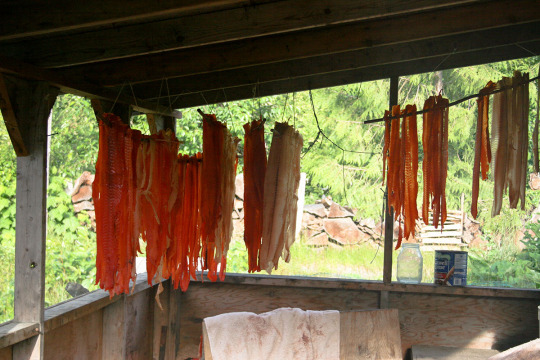
Hanging salmon in the village of Gingolx, British Columbia
Using the clunky old cassette-loaded camcorder I had back then, I filmed the day’s events, including a terrifying encounter with an aggressive mother grizzly and cubs. Watch the video below!
undefined
youtube
#nature#british columbia#indigineous people#nisgaa#canada#explore#explorebc#blog#new blog#travel#travel blog#exploration#fishing#salmon#fish food#lava
0 notes